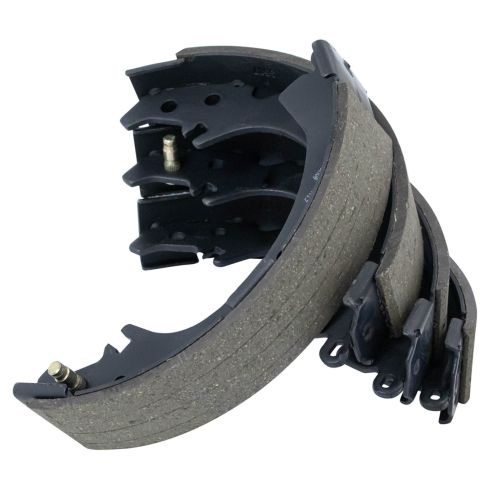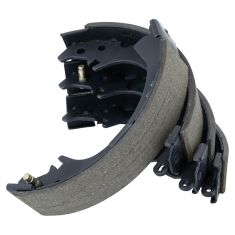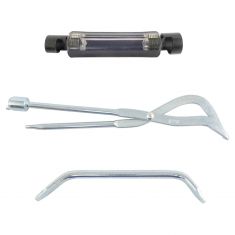Brought to you by 1AAuto.com, your source for quality replacement parts and the best service on the Internet.
Hi, I'm Mike from 1A Auto. I hope this how-to video helps you out, and next time you need parts for your vehicle, think of 1AAuto.com. Thanks.
In this video we're going to be working with our 1998 Toyota Camry. We're going to show you how to remove and replace all of your rear drum brake components, meaning the drum, the shoes, and the hardware that goes along with it. We’re also going to show you how to adjust it to make sure that your brakes are right up top and stop the way they should.
If you like this video, please click subscribe. We have a ton more info on this car, as well as many other makes any models. If you want this kit for your vehicle, it's available from 1AAuto.com. You can follow the link down in the description.
Here are the items you'll need for this repair: 14mm-21mm socket, ratchet, socket extension, needle nose pliers, flat blade screwdriver, breaker bar, torque wrench, brake cleaner, drain bucket, jack and jack stands
Grab onto the hubcap and remove it from the wheel. We're going to use a 21mm socket and breaker bar to remove all five lug nuts. Then raise and support the vehicle, and then finish removing the lugs.
We've put our vehicle on a lift to make it easier to film for you. This job can be easily done with a jack and jack stands.
Remove the wheel and tire.
Remove the drum. You may want to wear a dust mask when working inside of your brake components, as it can become airborne while you're working. Use a pair of needle nose locking pliers to unhook the springs from the brake shoes.
Using a pair of needle nose locking jaw pliers, grab onto the upper spring. Make sure that these are on there nice and tight, because these springs are under quite a bit of tension. Pull out and release the spring from its retainer. You can now use a pair of regular pliers. Support the back of the pin and the back of the plate here. Push down onto this cap and rotate it 90 degrees to remove it and the spring from this retainer pin. You can now remove this brake shoe and the pin from the backing plate.
Now we'll do the same thing to remove this spring retainer from the opposite side. Be careful when removing the shoe, because we have a lot more moving parts here you're going to have to deal with. We use those same needle nosed locking jaw pliers to grab onto the end of our emergency brake cable and work it out of the clip. Remove this snap clip carefully with a flat blade screwdriver. These are spring loaded, so if you snap them out too fast, they'll go flying; and they're very difficult to find.
Work the arm off of that pin. Flip over the brake shoe and remove the arm from the spring, as well as removing the spring from the brake shoe. You can now remove the adjuster. Unhook the spring from the backside and remove this horseshoe clip here. These can be pretty tricky, and there's a few different ways you can remove them. I like to try to spread them with a flat blade screwdriver. Once they're spread open a little bit, sometimes you can just press them off using the edge of the screwdriver. You may have to get a pair of pliers on there. Try and grab the back of the pin and the front of the clip and push it off that way. Can get a little stuck there. Finish prying it off with the screwdriver. We'll remove the arm from our old brake shoe.
Here we have our old brake setup that we removed from the vehicle, and our new kit from 1AAuto.com. As you can see, we have the same drum here. We have the same shoes and the same pin for our e-brake hardware. It comes with new pins and retainer springs, a new spring for our auto adjuster, the lower spring and upper springs for the shoes themselves, as well as a new horseshoe clip to retain all of our e brake hardware in place.
As you can see, our forward shoe is worn out a lot more than our rearward shoe is. This is not uncommon just because of the way drum brakes work. They actually move into the drum at somewhat of an angle, so the brunt of the braking force is taken by the front on this style brake setup. Your rear brakes are generally responsible for less, if not far less, than 50% of the braking in your vehicle, which means them wearing out and becoming soft may not be incredibly noticeable.
Some very common symptoms include the front brakes locking up because your rear brakes are designed to start braking first to keep the vehicle from nosediving under hard braking or braking from high speed. If you brake and your front brakes lock up and the rear seems to not be slowing the vehicle down, or you seem to go into a heavy nosedive, your rear brakes could be worn out or out of adjustment. Or you may notice that your e brake handle doesn't start to get tight until it's very high up, or that the e brake doesn't hold at all. If your rear shoes and drums are worn out, this new kit from 1A Auto is going to go in, direct fit, just like your original equipment, and fix you up right.
Place a catch pan underneath your backing plate, and spray the surface down with brake cleaner. We're also going to spray down our e-brake hardware and our adjuster wheel. These don't have to be perfect, but we do want to remove the majority of the buildup from them to make sure they go in easily and move smoothly.
Reinstall the e-brake actuator arm here. Put on a new horseshoe clip. Make sure you clock it so you can access the open end easily. This will rotate once you get it on, though. We're going to make sure that it's fully seated with a pair of pliers. Turn it so we can get at it. We'll clamp the ends together with our pliers until we close the gap. We'll tighten down our adjuster arm all the way. We'll send our spring back over it. Hook our spring into place at the back. This one's got kind of an odd hook on it, so it can be a little tricky to get in there.
Make sure this pin sits up. That's where we'll install our adjuster arm and the snap ring for our adjuster arm. You may also have to snap that on with a pair of pliers. Flip it over. Reinstall the small spring. Now we're ready to reinstall our shoes into the vehicle.
We'll send our retainer pin in through the back of the dust shield here with the backing plate. We'll install our shoe. Install the first retainer clip upside down, and turn it to keep it locked into place. Insert the new spring and retainer over the pin with the pair of pliers. Rotate it 90 degrees to lock it into place.
Set up our e-brake cable. You'll have to hold back the spring here. Sometimes you can push it against the clip. You may have to carefully pull it back with pliers so we can set our cable back into the retainer. Send this pin through the backing plate. Set the shoe into position. Send the pin through, and we'll put our retaining plate on upside down here. We'll set up our pliers and install our other spring plate the same way. Now we'll hook onto this spring with a pair of needle nosed locking pliers. Make sure that this slot lines up into this channel here, and we hook it into this hole at the very back of the shoe. Be careful when doing this and make sure that your pliers are locked on tight, because these springs do have a good bit of tension on them. We'll hook our lower spring in and again, and we'll grab on nice and tight. Make sure that it's behind this ear. We kind of have to pull this one and rotate it into the slot.
The brake adjuster is located here right below the wheel cylinder. We can access it through this hole in the hub. What this does is as we turn it, it spreads the shoes out. We'll install our brake drum with this hole on the drum over the opening in the hub. Line it up to the wheel. We'll run the adjuster out until the shoes just slightly drag on the inside surface of the drum.
Here, we have a little rubber plug in our brake drum to cover that adjuster wheel and keep dirt, debris, and moisture out of our brakes. We'll just push that out with the old drum with the screwdriver, and then we'll population it into our new drum. You can hear there, we have just a light bit of dragging from our shoes.
We'll reinstall our wheel and tire, test drive to make sure it's all right, and if we have to, we can simply pop this out with a screwdriver from the outside and adjust that wheel up or down as necessary.
Reinstall the wheel and tire. Get all the lug nuts down as tight as you can by hand. Lower the vehicle carefully back onto the wheel and tire. Torque the lug nuts to 76 foot-pounds in a cross pattern. Line up the notch in the hubcap over the valve stem. Tap the hubcap back into place.
Thanks for tuning in. We hope this video helped you out. Next time you need parts for your car, please visit 1AAuto.com. Also check out our other helpful how-to and diagnosis videos.












